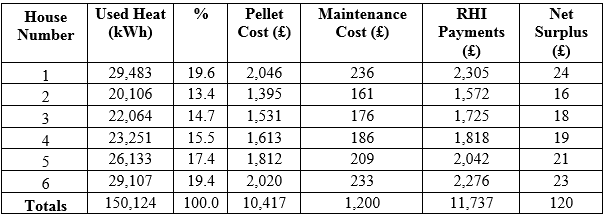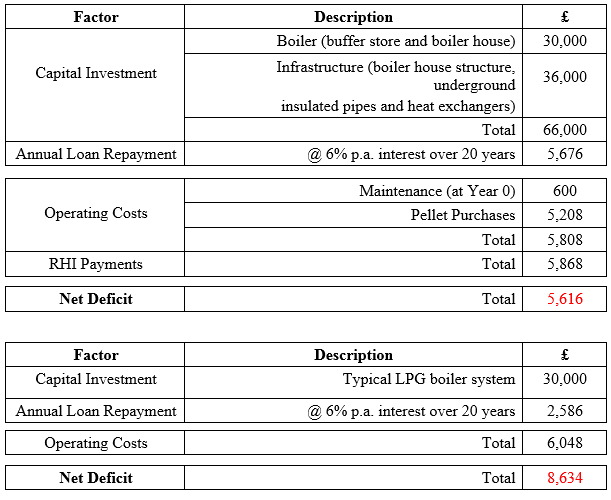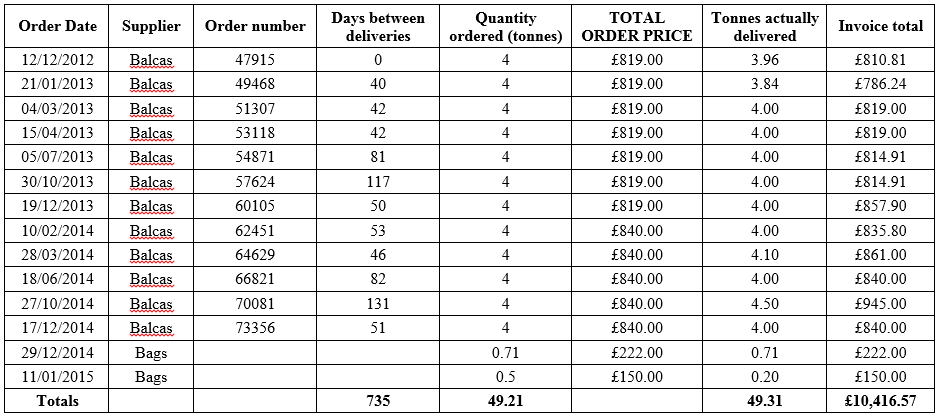data
Table 1. Used Soillse heat over the period 6.1.2013 - 6.1. 2015 with associated operational costs.
Table 2. District heating financial results, concentrating on a specific analysis of the central
biomass system for all six houses collated within the Soillse housing district. A reference
LPG boiler is quoted and will form the basis of any qualitative financial conclusions drawn.
biomass system for all six houses collated within the Soillse housing district. A reference
LPG boiler is quoted and will form the basis of any qualitative financial conclusions drawn.
All data above was supplemented by a biomass pellet order sheet, provided below for reference.
Table 3. Pellet deliveries for the period 6.1.2013 – 6.1.2015.
For the solar thermal panels each Soillse house paid for their own installation, a single panel of sectional area 3m^2. Given the relative “cheapness” of installation, it is assumed that the cost of installation is paid upfront (Year 0) to negate expensive loan repayment interest fees. The fact that all house owners received a Renewable Heat Premium Payment (RHHP) to assist with initial installation costs would appear to add to the credibility of this assumption. Although this subsidy is typically deducted from Non-Domestic RHI payments to remove any potential of “double subsidising”, the solar thermal technology must be treated independently from the biomass system in this scenario and, as stated previously, within the thermal store configuration solar thermal is not eligible for RHI payments.
For the purpose of presentation, all financial results may be compiled into an overall analysis of the Soillse housing district – see the Table below. In consistency with provided data for the biomass system, annual maintenance costs of the solar thermal panels are assumed to be 2% of the initial installation and modelled to increase modestly by 2.5% annually to reflect degrading system performance and equivalently increased level of required maintenance.
For the purpose of presentation, all financial results may be compiled into an overall analysis of the Soillse housing district – see the Table below. In consistency with provided data for the biomass system, annual maintenance costs of the solar thermal panels are assumed to be 2% of the initial installation and modelled to increase modestly by 2.5% annually to reflect degrading system performance and equivalently increased level of required maintenance.
Table 4. District heating financial results, concentrating on a specific analysis of the
solar thermal system, for all six houses collated within the Soillse district.
solar thermal system, for all six houses collated within the Soillse district.
In the above table it is not applicable to look at the net deficit as there is a combination of upfront, one off payments and running operational costs which will additionally appreciate with time. This touches on an important point. Paying the capital investment up front, rather than spreading payments over a similar loan period to that of the biomass boiler, will be to the detriment of the payback period. However this will produce greater financial feasibility over the assumed technology lifetime. This indicates that payback period is something of a false representation of renewable technology’s financial feasibility, and may commonly have been exploited by relevant parties to justify their end aim. It is important in this financial feasibility analysis to consider both factors, payback period and overall saving/cost, with equal weight.




